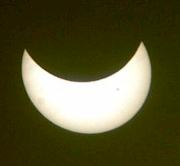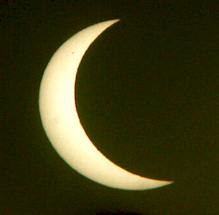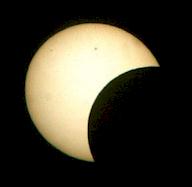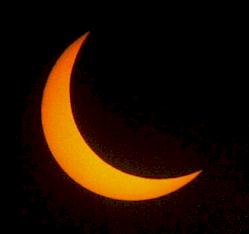


SD Prep Sports: Astronomy
www.geocities.com/sdprepsports
E-mail us at [email protected]
Home Swimming/Diving Cross Country Track & Field Roller Hockey Water Polo CIF Scorecard



The progress of the June 10 partial solar eclipse as viewed by eyepiece projection.
Photos by Phillip Brents
Observers follow the shrinking sun
By Phillip Brents
Science Editor
 CHULA VISTA, June 10,
2002 -- For those anxiously crossing their fingers in the hopes of clear
skies for Monday’s partial solar eclipse, the heavens miraculously parted at
midday, the marine layer receded and skywatchers of all ages throughout San
Diego County got a chance to view what was the American mainland’s best sampling
of the celestial showcase event.
CHULA VISTA, June 10,
2002 -- For those anxiously crossing their fingers in the hopes of clear
skies for Monday’s partial solar eclipse, the heavens miraculously parted at
midday, the marine layer receded and skywatchers of all ages throughout San
Diego County got a chance to view what was the American mainland’s best sampling
of the celestial showcase event.
Telescopes, some set up with impromptu projection screens for public viewing, cameras balanced on tripods and people simply holding a peep-hole in a piece of cardboard at arm’s length could be seen taking advantage of the once-in-a-decade opportunity.
Even those who had no prior knowledge of the event were drawn in by its uniqueness.
Sean Jameson, 20, who lives near Bayside Park in Chula Vista, stumbled upon one of the best viewing sites in Chula Vista by accident. He soon was in line to look through the eyepiece of Chula Vista resident Steven Cicchetti’s 8-inch Celestron telescope parked alongside a companion 5-inch scope in the park.
“I didn’t even know about the eclipse,” said the graduate of Chula Vista High School who now owns a tattoo and body piercing shop in downtown San Diego. “I saw all these people with telescopes set up and I came down to see what they were looking at. It was sick.”
Cicchetti, who took the day off from work to set up his impressive array of equipment just above the shoreline, is a member of the San Diego Astronomical Association. He had a 35mm camera attached to the end of the telescope at prime focus to capture the phenomenon on film as well as an eyepiece set up for public viewing at 50 magnification. He used a Bader Planetarium filter to reduce the sun’s glare for safe viewing with the human eye.
Jameson was one of many who stopped by to satisfy their curiosity.
Though impressive by local standards, the eclipse was even more spectacular for observers in open seas below the tip of Baja California where they saw an annular eclipse. In an annular eclipse, the moon’s image is smaller than the sun’s and a ring of the sun’s surface is visible against the blackened image of the moon. For observers in the western United States, the eclipse exhibited partial phases.
First contact came at 5:15 p.m. when the moon took out its first bite from the sun. Maximum coverage occurred at 6:24 p.m. when 80 percent of the sun’s diameter (74 percent of its surface area) was blotted out. Final contact was at 7:24 p.m., though incoming cloud cover had likely obscured the eclipse for most observers by then.
Local observers will not be treated to another eclipse of this magnitude until May 20, 2012.
Cicchetti thus did not hold back anything for Monday’s event. Both his scopes were driven by precision clock drives to keep the sun’s image from escaping the field of view. Portable battery packs powered both clock drives.
Cicchetti said he often goes out to the association’s site in Tierra del Sol for star parties and has photographed lunar landscapes, galaxies and nebulae with his telescopes. He came prepared for Monday’s sky show. Cicchetti said he viewed 1992’s spectacular annular eclipse also from Bayside Park, though he did not have a camera with him at that time and instead watched it on a projection screen.
Several other telescopes were set up around Cicchetti’s observing station. “Oh, the sun is orange now!” a young girl excitedly exclaimed after a yellow filter was placed on top of an eyepiece to project a color image of the cut-up Sun. A red filter and then a blue filter produced a similar response.
Telescopic views showed the moon’s advancing limb engulfing large groups of sunspots as the eclipse neared its maximum phase when light levels and temperatures noticeably dropped.
A small child building a sand castle along the water’s edge was not impressed by all the commotion, however.
Even those who had to work found time to get a peek at the celestial display. EastLake resident Manny Ramirez photographed the eclipse just before maximum while on a break from his job at the North Island Naval Depot. He used a 210mm zoom lens on his Nikon N80 camera stocked with 400 ASA film to capture the crescent sun with coastal clouds acting as a natural filter.
Monday’s eclipse was not the first he had witnessed.
“I observed a total eclipse from the Philippines, maybe in the 1960s, and I was fascinated by that,” he said.
While Monday’s eclipse offered breathtaking views, there were also some drawbacks. Manufacturers will likely be flooded with claims by camera owners who blew out their video or digital cameras by pointing them at the sun.
For information on the San Diego Astronomical Association, visit the Web site at www.sdaa.org.